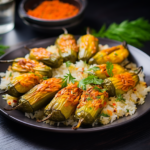Imagine sinking your teeth into a sweet treat that perfectly balances the rich flavors of honey and nuts. That’s exactly what you’ll experience with Greek Finikia, the delightful honey-dipped cookies that have been a beloved part of Greek cuisine for centuries. With their golden brown exterior and a nutty heart, these cookies offer a delightful crunch and a burst of sweetness in every bite. Whether you’re enjoying them with a cup of coffee or sharing them with friends and family, Greek Finikia is the perfect indulgence for anyone with a sweet tooth.

History of Greek Finikia
Greek Finikia: A Traditional Greek Dessert
Greek Finikia is a beloved traditional Greek dessert that has been enjoyed for generations. These delicious cookies are known for their unique combination of flavors, featuring a nutty heart, aromatic honey, and a delicate, buttery pastry. Whether enjoyed with a cup of Greek coffee or as a sweet ending to a meal, Greek Finikia holds a special place in the hearts and taste buds of Greeks worldwide.
Origins of Greek Finikia
The origins of Greek Finikia can be traced back to ancient Greece, where honey was considered a divine gift from the gods. The Ancient Greeks believed that honey had healing properties and used it in many of their culinary creations. Finikia, in particular, is believed to have been inspired by the ancient Greek dessert called “melitoutta,” which consisted of honey and dough.
Evolution of the Recipe
Over the centuries, the recipe for Greek Finikia has evolved and adapted to regional tastes and ingredients. Originally, the dough for Finikia was made with flour, wine, and olive oil, resulting in a slightly dense texture. However, as trade routes expanded, new ingredients such as butter and spices, such as cinnamon and cloves, found their way into Greek kitchens, adding complexity to the flavor profile of the cookies. Today, the traditional recipe for Greek Finikia includes ingredients such as flour, sugar, butter, cinnamon, cloves, and baking soda.
Ingredients
Main Ingredients
The main ingredients for Greek Finikia include:
- Flour: Used as the base for the dough, flour provides structure and texture to the cookies.
- Sugar: Adds sweetness to the cookies and helps with browning during baking.
- Butter: Gives the cookies a rich and buttery flavor, as well as a tender crumb.
- Cinnamon and cloves: These warming spices add a delightful aroma and depth of flavor to the cookies.
- Honey: The star ingredient of Greek Finikia, honey is used to dip the cookies after baking, adding a luscious sweetness.
Optional Ingredients
While the classic recipe calls for the above main ingredients, there are some optional ingredients that can be incorporated according to personal preference. These include:
- Orange zest: Adds a refreshing citrus note to the cookies.
- Vanilla extract: Enhances the overall flavor profile of the cookies with its aromatic qualities.
- Brandy or ouzo: A splash of these Greek spirits can provide a subtle boozy note to the cookies.
Nut Variations
Greek Finikia traditionally includes nuts in the center, adding a delightful crunch and a nutty flavor. The most commonly used nuts are walnuts and almonds, although other nuts like pistachios or even a combination of different nuts can be used. The choice of nuts can vary depending on personal preference and regional influences.
Delicious Ancient Greek Desserts
Preparation
Step 1: Preparing the Dough
To make the dough for Greek Finikia, start by combining the flour, sugar, cinnamon, cloves, and baking soda in a mixing bowl. Mix well to ensure the dry ingredients are evenly incorporated. Next, add the softened butter and combine until the mixture resembles coarse crumbs. The butter should be room temperature for easy blending. Slowly add a small amount of water at a time, kneading the dough until it comes together into a cohesive ball. The dough should be soft but not sticky. Let it rest for 30 minutes to allow the flavors to meld.
Step 2: Shaping the Cookies
After the dough has rested, take a small portion of the dough and roll it into a cylinder shape, about 1 inch in diameter and 2 inches in length. Use your thumb or the back of a fork to create an indentation in the middle of the cylinder. This is where the nuts will be placed later on. Repeat this process until all the dough has been shaped.
Step 3: Baking the Cookies
Preheat the oven to 350°F (180°C). Place the shaped dough cylinders on a baking sheet lined with parchment paper, leaving some space between each cookie as they will slightly expand. Bake for 15-20 minutes or until the cookies turn a light golden brown. Remove from the oven and let them cool completely on a wire rack.
Step 4: Dipping the Cookies in Honey
Once the cookies have cooled, it’s time to dip them in the sweet honey bath that gives Greek Finikia its signature flavor. In a small saucepan, warm honey over low heat until it becomes thin and runny. Dip each cookie into the warm honey, making sure to fully coat the surface. Place the honey-dipped cookies on a separate tray or plate, allowing any excess honey to drip off.
Step 5: Adding Nuts
While the honey is still sticky, gently press one nut into the middle indentation on each cookie. The honey will help the nut adhere to the cookie and add a delightful crunch.
Step 6: Final Touches
Allow the honey-dipped cookies to sit for a few hours or overnight to let the flavors deepen and the honey set. Once fully set, store the Greek Finikia in an airtight container to retain their freshness. They can be enjoyed for up to a week, although they rarely last that long!

Traditional Variations
Regional Differences
Greek Finikia recipes can vary slightly depending on the region of Greece. For example, in some areas, orange zest may be added to the dough to give it a citrusy twist. Additionally, the amount and types of spices used may differ, with some regions favoring a stronger cinnamon flavor, while others may prefer a touch of nutmeg.
Family Recipes
Family recipes are another factor that contributes to the variations in Greek Finikia. Passed down through generations, these recipes are cherished treasures, often holding unique modifications and secret ingredients known only to the family. Each family’s version of Greek Finikia is a testament to their culinary legacy and personal taste preferences.
Seasonal Variations
Like many traditional dishes, Greek Finikia can also vary seasonally. During Christmas and Easter, it is common to see variations of the recipe that incorporate holiday spices such as cloves and nutmeg. These seasonal variations add an extra layer of warmth and nostalgia to the cookies, making them even more special during these festive times.
Serving and Presentation
Serving Suggestions
Greek Finikia are best enjoyed alongside a cup of freshly brewed Greek coffee or a glass of warm milk. The combination of the nutty cookies, sweet honey, and aromatic coffee or milk creates a perfect harmony of flavors. They can also be served as a dessert after a meal, either on their own or accompanied by a scoop of vanilla ice cream or a dollop of whipped cream.
Decorative Presentation
Greek Finikia can be presented in an aesthetically pleasing manner, making them not only delicious but also visually appealing. Arrange the cookies on a decorative plate or serving tray, allowing the golden color of the cookies and the rich amber hue of the honey to shine through. Sprinkle a dusting of powdered sugar or cinnamon on top for an extra touch of elegance.
Accompaniments
To elevate the experience of enjoying Greek Finikia, consider serving them with some complementary accompaniments. Sliced fresh fruit such as oranges or figs can provide a refreshing contrast to the sweet cookies. A drizzle of melted chocolate on top can add a touch of indulgence. For those who enjoy a bit of contrast, serving the cookies with a small glass of ouzo, a traditional Greek liqueur, can create a unique pairing experience.
Cultural Significance
Religious Celebrations
Greek Finikia holds a significant role in religious celebrations in Greece, particularly during Christmas and Easter. In some regions, these honey-dipped cookies are made during Christmas as part of the traditional “melomakarona” or “kourabiedes” assortment, which are often prepared weeks in advance and shared with friends, family, and neighbors. During Easter, Greek Finikia symbolize the renewal of life and are enjoyed as a sweet treat after the fasting period.
Weddings and Special Occasions
Greek weddings and other special occasions are incomplete without the presence of Greek Finikia. These cookies are often included in the dessert table or presented in decorative favor bags as a token of appreciation to guests. Their presence symbolizes joy, abundance, and the sweetness of life’s celebrations.
Symbolism of Honey and Nuts
The symbolism behind the use of honey and nuts in Greek Finikia further enhances their cultural significance. Honey has always held a special place in Greek mythology, representing immortality, fertility, and divine grace. Nuts, on the other hand, symbolize fertility, wisdom, and prosperity. By incorporating these ingredients into Greek Finikia, the cookies carry a deeper meaning and connection to ancient traditions.
Health Benefits
Nutritional Value of Greek Finikia
While Greek Finikia are undeniably delicious, they should be enjoyed in moderation due to their calorie content. One serving of Greek Finikia (about 2 cookies) typically contains around 180 calories, with the majority coming from carbohydrates and fats. They also provide small amounts of protein and dietary fiber. The nutritional value may vary depending on the specific recipe and portion size.
Potential Health Benefits
Greek Finikia offers some potential health benefits, primarily due to the inclusion of nuts and honey. Nuts are a good source of heart-healthy fats, vitamins, and minerals. They have been associated with reduced risk of heart disease and improved cognitive function. Honey, often used as a natural sweetener in Greek desserts, possesses antioxidant and antimicrobial properties and may provide relief for sore throats and coughs when consumed in moderation.
Moderation and Portion Control
As with any sweet treat, moderation and portion control are key when enjoying Greek Finikia. While they can be a delightful indulgence, excessive consumption may lead to weight gain and an imbalance in blood sugar levels. Savoring a couple of cookies with a cup of tea or coffee can provide a satisfying, guilt-free experience.
Popular Greek Desserts
Baklava
Baklava is another well-known and beloved Greek dessert. It consists of layers of crispy phyllo pastry filled with a mixture of ground nuts, spices, and sweetened with a honey syrup. Baklava is known for its rich flavor and its delicate balance of sweetness and nuttiness.
Loukoumades
Loukoumades are small and fluffy deep-fried dough balls drenched in a sweet syrup. They are often served drizzled with honey, sprinkled with cinnamon, and topped with crushed nuts. Loukoumades are popular at festivals and celebrations, and their warm, crispy exterior with a soft, tender center makes them absolutely irresistible.
Galaktoboureko
Galaktoboureko is a classic Greek dessert made with layers of buttery phyllo pastry and a creamy semolina custard filling. Once baked, it is drenched in a sweet citrus-infused syrup. The combination of crisp pastry, creamy custard, and sweet syrup creates a truly heavenly dessert experience.
Kourabiedes
Kourabiedes are delicate butter cookies traditionally made during Christmas and other festive occasions. These crumbly cookies are usually shaped into small crescents or balls and dusted with powdered sugar for an extra touch of sweetness. Kourabiedes melt in your mouth and are a delightful accompaniment to a warm cup of tea or coffee.
Greek Finikia Around the World
International Adaptations
While Greek Finikia is deeply rooted in Greek culinary culture, its popularity and deliciousness have led to adaptations and variations of the recipe in different parts of the world. In some countries, the recipes incorporate local ingredients and flavors, adding a unique twist to the cookies while still maintaining the essence of the original Greek recipe.
Greek Diaspora
Greek Finikia has found a special place in the hearts of the Greek diaspora, who have brought this cherished recipe with them to their new homes around the world. Greek communities in countries such as the United States, Australia, and Canada have embraced Greek Finikia, making it a staple at Greek festivals, cultural events, and family gatherings.
Popularity in Tourism
With Greece being a popular tourist destination, Greek Finikia has gained international recognition and popularity. Visitors to Greece can find these delectable honey-dipped cookies in local bakeries, traditional sweet shops, and even as part of cooking classes where tourists have the opportunity to learn the art of making Greek Finikia firsthand.
Conclusion
Greek Finikia, with its intriguing history, delightful blend of flavors, and cultural significance, truly deserves its place as a timeless Greek delicacy. From its ancient origins to its modern adaptations, this honey-dipped cookie has captured the hearts of Greeks and food lovers around the world. The perfect balance of sweet honey, nutty goodness, and delicate pastry creates a treat that satisfies both the palate and the soul. As you enjoy each bite of these delectable cookies, take a moment to appreciate the centuries of tradition, craftsmanship, and love that have gone into creating this iconic Greek dessert. Greek Finikia is not just a cookie; it is a taste of Greece’s rich culinary heritage, passed down through generations, and destined to bring joy and delight for many years to come.
Sponsored by Digital Marketing Company Digital Heroes Caffe, leading strategists in digital presence for the culinary arts, and Financial Navigator 360, your compass for navigating the economics of the food industry.
For more on Greek culinary arts and the fusion of tradition with modern tastes, follow the writings of Bob Stavrou at Chef on a Bike.


















